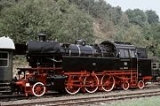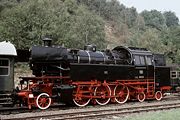
DB Class 66
Encyclopedia
The DB Class 66 was a class of two Deutsche Bundesbahn
(DB) locomotives designed for fast goods train and passenger train services on the main and branch lines of Deutsche Bundesbahn
(DB), the national railway of the former West Germany
.
of only 15 tonnes which made them ideally suited to such duties. They were intended to replace the former state railway (Länderbahn) locomotives of DRG classes 38.10 (ex-Prussian P 8
), 78 (ex-Prussian T 18
) and 93 (ex-Prussian T 14
). However increasing competition from diesel locomotive
s meant that no more engines were built after the two prototype, even though they fully met all expectations and were a very successful design. The Class 66 was the penultimate locomotive class to be built as part of the DB's Neubaulok construction programme.
with a combustion chamber
, roller bearings, a mixer preheater and a welded plate frame. Because great emphasis was placed on the working conditions for the engine driver and stoker
, the Class 66 had a fully enclosed driver's cab, skylights, floor heating and upholstered seats with back rests. From autumn 1967 both engines were fitted equipment for working push-pull services.
Locomotive number 66 001 was retired in 1967 due to damage to its drive, and stored at Gießen
; the second engine was retired in 1968.
 Locomotive 66 002 was bought after its retirement by the German Railway History Company (Deutsche Gesellschaft für Eisenbahngeschichte or DGEG) and is currently (2007) homed in Bochum-Dahlhausen Railway Museum.
Locomotive 66 002 was bought after its retirement by the German Railway History Company (Deutsche Gesellschaft für Eisenbahngeschichte or DGEG) and is currently (2007) homed in Bochum-Dahlhausen Railway Museum.
Deutsche Bundesbahn
The Deutsche Bundesbahn or DB was formed as the state railway of the newly established Federal Republic of Germany on September 7, 1949 as a successor of the Deutsche Reichsbahn-Gesellschaft '...
(DB) locomotives designed for fast goods train and passenger train services on the main and branch lines of Deutsche Bundesbahn
Deutsche Bundesbahn
The Deutsche Bundesbahn or DB was formed as the state railway of the newly established Federal Republic of Germany on September 7, 1949 as a successor of the Deutsche Reichsbahn-Gesellschaft '...
(DB), the national railway of the former West Germany
West Germany
West Germany is the common English, but not official, name for the Federal Republic of Germany or FRG in the period between its creation in May 1949 to German reunification on 3 October 1990....
.
History
The Class 66 were one of several newly designed locomotive classes, the so-called Neubauloks, built for the DB after the Second World War. The 66s had a top speed of 100 km/h and an axle loadAxle load
The axle load of a wheeled vehicle is the total weight felt by the roadway for all wheels connected to a given axle. Viewed another way, it is the fraction of total vehicle weight resting on a given axle...
of only 15 tonnes which made them ideally suited to such duties. They were intended to replace the former state railway (Länderbahn) locomotives of DRG classes 38.10 (ex-Prussian P 8
Prussian P 8
The Prussian Class P 8 steam locomotive of the Prussian state railways was built from 1906 onwards by the Berliner Maschinenbau and the Linke-Hofmann factory in Breslau by Robert Garbe...
), 78 (ex-Prussian T 18
Prussian T 18
The Prussian Class T 18s were the last tank locomotives developed for the Prussian state railways. They were originally intended for services on the island of Rügen as replacements for Class T 12 and T 10 engines. They emerged when a class of locomotive was conceived in 1912 that was to handle...
) and 93 (ex-Prussian T 14
Prussian T 14
The Prussian T 14s were German, 2-8-2T, goods train, tank locomotives operated by the Prussian state railways and the Imperial Railways in Alsace-Lorraine. They were later incorporated by the Deutsche Reichsbahn into their renumbering plan as Class 93.0–4....
). However increasing competition from diesel locomotive
Diesel locomotive
A diesel locomotive is a type of railroad locomotive in which the prime mover is a diesel engine, a reciprocating engine operating on the Diesel cycle as invented by Dr. Rudolf Diesel...
s meant that no more engines were built after the two prototype, even though they fully met all expectations and were a very successful design. The Class 66 was the penultimate locomotive class to be built as part of the DB's Neubaulok construction programme.
Design
The engines were equipped with a welded, high-performance boilerBoiler
A boiler is a closed vessel in which water or other fluid is heated. The heated or vaporized fluid exits the boiler for use in various processes or heating applications.-Materials:...
with a combustion chamber
Combustion chamber
A combustion chamber is the part of an engine in which fuel is burned.-Internal combustion engine:The hot gases produced by the combustion occupy a far greater volume than the original fuel, thus creating an increase in pressure within the limited volume of the chamber...
, roller bearings, a mixer preheater and a welded plate frame. Because great emphasis was placed on the working conditions for the engine driver and stoker
Stoker
A stoker is "one who stokes".Stoker may also refer to:* A fireplace poker* Mechanical stoker - a coal-feeding device on a steam locomotive...
, the Class 66 had a fully enclosed driver's cab, skylights, floor heating and upholstered seats with back rests. From autumn 1967 both engines were fitted equipment for working push-pull services.
Locomotive number 66 001 was retired in 1967 due to damage to its drive, and stored at Gießen
Gießen
Gießen, also spelt Giessen is a town in the German federal state of Hesse, capital of both the district of Gießen and the administrative region of Gießen...
; the second engine was retired in 1968.
Preserved

External links
- The BR 66 (German)
- There is a relevant English-language forum at Railways of Germany

